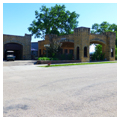You are here
Palace Lodge
The E. W. Norris Service Station is something of an architectural curiosity; it is a small-town gas station modeled after a European castle. The owner, Ernest W. Norris, or Ernie as he was commonly known, served in the army during the World War I, and was part of the occupation force in Germany. When he returned home to Glenn Elder, Ernie was determined to open a service station, and he wanted it to be a reminder of the architecture he had seen while living abroad. He hired Frank Slack, an architect from the nearby town of Beloit, and presented him with a sketch of his vision.
The most striking feature of the station is the great vaulted canopy on the front that sheltered the gas pumps. It is supported at the corners by four crenelated towers. The front towers facing the street to the north are barely large enough for a good-sized closet, but they each have a round-arched window facing the street, and a similarly shaped door opening on the opposite side of the tower. The other two towers are engaged with the slightly lower building mass to the rear. Windows on the east and west sides of these towers match the form of the doors on the front towers. The form of the canopy’s vault is shown through the wide segmented arches that carry the three open sides.
The rear portion of the service station houses the office and men’s and women’s restrooms. A central door with large windows on either side provides easy access and good visibility to the canopy area. The restrooms and a basement storage space are accessible from the east and west sides of the building.
Ernie was proud of his new station. As he had hoped, its unique appearance attracted customers traveling on U.S. Route 24. In 1929, three years after completion of the station, Ernie was able to commission Slack to design a garage building for oil changes and minor repairs. Located to the east of the rear portion of the original structure, the garage building facade matches the station’s canopy, with towers at the corners and a wide, segmented arch above the central garage door.
The entire structure was built with locally quarried limestone called Post Rock. It was given this name because the limestone in this part of Kansas is found in relatively thin layers, and the six-to-eight-inch deep veins of rock are easily split into long, thin strips, which make durable and fireproof fence posts. Post Rock is recognizable by a streak of darker, brown rock that often runs down the center of the vein of pale gray stone.
Unfortunately, Ernie was forced to close his business when U.S. Route 24 was relocated to bypass Glen Elder. For many years the building sat vacant. In 2012, Dan and Linda Winkel, who had long admired the building, converted the office portion of the station into lodging for tourists visiting nearby Glen Elder State Park and Waconda Lake. While the transformation of the space beneath the grand canopy into a front porch makes it difficult to imagine the building’s original function, the old service station once again contributes to the life of the town.
References
Pankratz, Richard, and Cornelia Wyma, “E. W. Norris Service Station,” Mitchell County, Kansas. National Register of Historic Places Inventory-Nomination Form, 1976. National Park Service, U.S. Department of the Interior, Washington, D.C.
Writing Credits
If SAH Archipedia has been useful to you, please consider supporting it.
SAH Archipedia tells the story of the United States through its buildings, landscapes, and cities. This freely available resource empowers the public with authoritative knowledge that deepens their understanding and appreciation of the built environment. But the Society of Architectural Historians, which created SAH Archipedia with University of Virginia Press, needs your support to maintain the high-caliber research, writing, photography, cartography, editing, design, and programming that make SAH Archipedia a trusted online resource available to all who value the history of place, heritage tourism, and learning.






